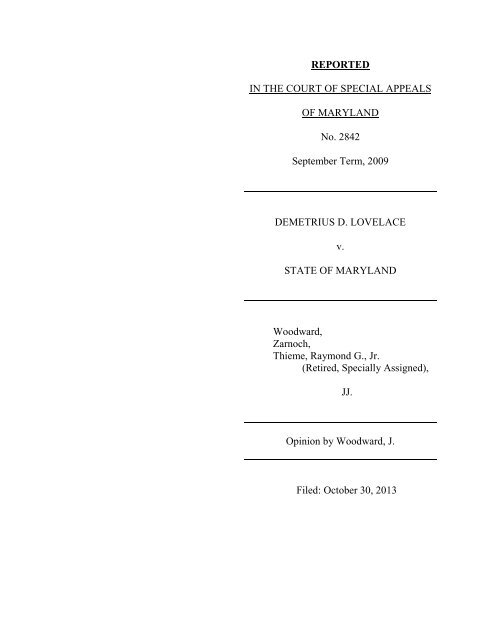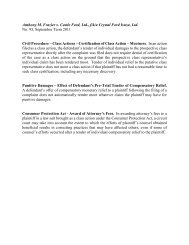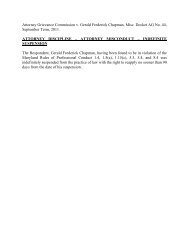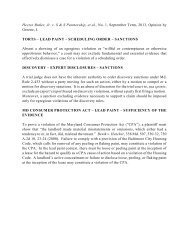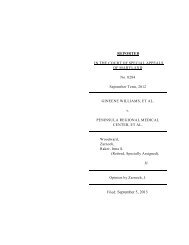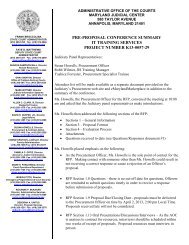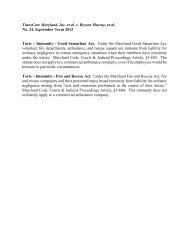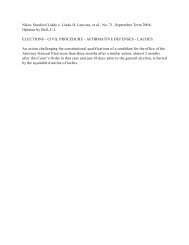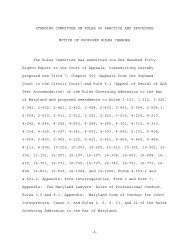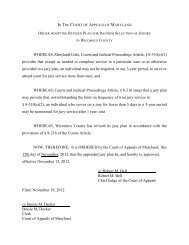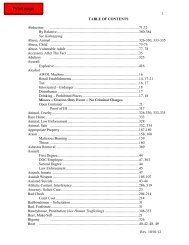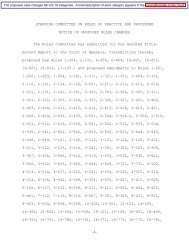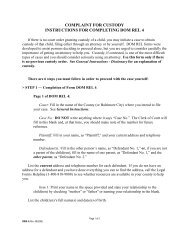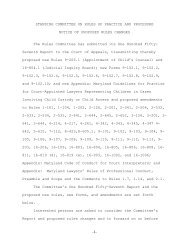2842/09 - Maryland Courts
2842/09 - Maryland Courts
2842/09 - Maryland Courts
Create successful ePaper yourself
Turn your PDF publications into a flip-book with our unique Google optimized e-Paper software.
REPORTED<br />
IN THE COURT OF SPECIAL APPEALS<br />
OF MARYLAND<br />
No. <strong>2842</strong><br />
September Term, 20<strong>09</strong><br />
DEMETRIUS D. LOVELACE<br />
v.<br />
STATE OF MARYLAND<br />
Woodward,<br />
Zarnoch,<br />
Thieme, Raymond G., Jr.<br />
(Retired, Specially Assigned),<br />
JJ.<br />
Opinion by Woodward, J.<br />
Filed: October 30, 2013
Demetrius D. Lovelace, appellant, was arrested on April 1, 2008, in connection<br />
with the death of Alan Zurita. On November 12, 2008, appellant was indicted on<br />
fourteen counts, including first degree murder. Beginning on November 2, 20<strong>09</strong>, a jury<br />
trial was held in the Circuit Court for Harford County. At the close of the State=s<br />
case-in-chief on November 9, 20<strong>09</strong>, the court granted defense counsel=s Motion for<br />
Judgment of Acquittal as to first degree premeditated murder, which limited that charge<br />
to first degree felony murder. On November 12, 20<strong>09</strong>, the jury found appellant guilty of<br />
the following charges: (1) first degree felony murder; (2) robbery with a dangerous<br />
weapon; (3) robbery; (4) attempted robbery; (5) conspiracy to commit robbery; (6)<br />
possession of a firearm by a person convicted of a felony; (7) possession of a firearm by a<br />
person convicted of a crime of violence; and (8) possession of a firearm by a person<br />
convicted of a disqualifying crime.<br />
On January 25, 2010, the trial court merged for sentencing purposes the<br />
convictions for robbery and attempted robbery into robbery with a dangerous weapon,<br />
and merged the convictions for possession of a firearm by a person convicted of a crime<br />
of violence and possession of a firearm by a person convicted of a disqualifying crime<br />
into possession of a firearm by a person convicted of a felony. The trial court sentenced<br />
appellant to life imprisonment without parole for the first degree felony murder<br />
conviction, twenty years for robbery with a dangerous weapon, fifteen years for<br />
conspiracy to commit robbery, and five years for possession of a firearm by a person<br />
convicted of a felony. The sentences for robbery with a dangerous weapon, conspiracy
to commit robbery, and possession of a firearm were to be served consecutively to each<br />
other, but concurrently with the sentence for first degree felony murder. Appellant was<br />
also ordered to pay restitution in the amount of $10,408.00 for Zurita=s hospital and<br />
funeral bills.<br />
rephrased:<br />
On appeal, appellant presents four questions for our review, which we have<br />
1. Did the trial court err in denying appellant=s motion to suppress?<br />
2. Did the trial court err in failing to merge the conviction for robbery<br />
with a dangerous weapon into the first degree felony murder<br />
conviction for the purpose of sentencing?<br />
3. Did the trial court err in failing to follow up on a question<br />
answered in the affirmative during voir dire of the venire?<br />
4. Did the trial court err by admitting a photograph of the victim with<br />
a family member?<br />
For the reasons set forth herein, we answer questions 1, 3, and 4 in the negative, and answer<br />
question 2 in the affirmative. Accordingly, we shall vacate the sentence for robbery with a<br />
dangerous weapon and otherwise affirm all of the remaining judgments of the circuit court.<br />
BACKGROUND 1<br />
On April 1, 2008 at approximately 1:45 a.m., a red Mitsubishi Galant, driven by appellant,<br />
with Damon Jackson and Zurita as passengers, entered southbound on I-95 near Havre de Grace,<br />
1 Because appellant does not challenge the sufficiency of the evidence to sustain his<br />
convictions, we will provide only a brief background of the facts of the case to provide<br />
context for our discussion of the issues presented. See, e.g., Bey v. State, 140 Md. App.<br />
607, 611 (2001), cert. denied, 368 Md. 526 (2002).<br />
2
<strong>Maryland</strong>. There was a plan between appellant and Jackson to rob Zurita. While appellant was<br />
driving, Jackson and Zurita got into a fight, and Jackson was shot. Appellant then stopped the car<br />
on the shoulder of southbound I-95; Zurita exited the vehicle followed by Jackson. Jackson shot<br />
and killed Zurita. Appellant then drove Jackson to the hospital, dropped him off in front of the<br />
emergency room, and left. The police found Zurita=s body on the shoulder of southbound I-95 at<br />
2:30 a.m. the same day.<br />
At approximately 12:00 p.m. on April 1, 2008, appellant was arrested and taken to the<br />
<strong>Maryland</strong> State Police Forestville Barracks. At the barracks, appellant made statements to three<br />
officers, Sergeant Christina Becker, Corporal Richard Bachtell, and Corporal Michael Mann, over<br />
the course of two separate interviews. At the conclusion of the second interview, appellant gave a<br />
recorded statement and described the fight between Jackson and Zurita as a Arobbery gone bad.@<br />
Additional facts will be set forth herein to resolve the questions presented.<br />
DISCUSSION<br />
I.<br />
Statements<br />
First Interview<br />
At approximately 1:15 p.m., Sgt. Becker and Cpl. Bachtell advised appellant of his<br />
Miranda rights, and appellant subsequently invoked his right to remain silent. According to Sgt.<br />
Becker, appellant Acontinued to speak@ after invoking his right to remain silent, which prompted<br />
Sgt. Becker and Cpl. Bachtell to Acut [appellant] off@ and explain that they could not speak with<br />
him unless he waived his Miranda rights. Approximately ten minutes after appellant=s initial<br />
3
advice of Miranda rights, at 1:25 p.m., Sgt. Becker re-advised appellant of his Miranda rights, and<br />
appellant signed a form waiving his rights.<br />
Thereafter, appellant told Sgt. Becker and Cpl. Bachtell that he had gone to Aberdeen to<br />
see a friend and while he was there, he saw Jackson. Later, according to appellant, when he was<br />
driving home, appellant received a call from Jackson to come back and pick Jackson up at his<br />
home. Appellant said that he made a U-turn, went back to where Jackson was residing and saw<br />
him Astanding on the side of the building bleeding and gagging and sweating.@ Appellant stated<br />
further that Jackson got into his car, and appellant drove him to the hospital, where appellant<br />
dropped him off in front of the emergency room and left.<br />
At some point during the interview, Sgt. Becker played for appellant a ten-second portion<br />
of a recorded interview in which Jackson claimed that appellant shot Zurita and Jackson. The<br />
interview with appellant concluded shortly thereafter at approximately 2:55 p.m.<br />
Second Interview<br />
At approximately 5:30 p.m., appellant was removed from his holding cell and interviewed<br />
by Sgt. Becker and Cpl. Mann in the same room as the first interview. Sgt. Becker did not<br />
re-advise appellant of his Miranda rights, but Aremind[ed] [appellant] that, in fact, his Miranda<br />
[r]ights that [she] read to [appellant] earlier, in fact, were still in effect.@ In addition, at appellant=s<br />
request, the officers replayed approximately one minute of Jackson=s recorded interview.<br />
Appellant then provided a statement in which he stated that Athere was a plan and talk between<br />
[Jackson] and [appellant] that they were going to rob [Zurita],@ and that it was Aa robbery gone<br />
bad.@ Appellant also stated that, as he was driving, Zurita and Jackson began fighting and Jackson<br />
4
was shot Aapparently accidentally.@ Thereafter, according to appellant, Zurita exited the vehicle,<br />
followed by Jackson, who shot and killed Zurita.<br />
In addition to detailing the planned robbery and the fight between Jackson and Zurita, Cpl.<br />
Mann testified that appellant described the gun that was used to kill Zurita and offered to show him<br />
where he had thrown the gun into a river in Harford County<br />
Recorded Statement<br />
At approximately 7:00 p.m., following his statements to Cpl. Mann and Sgt. Becker during<br />
the second interview, appellant provided a twenty-one minute recorded statement in which he<br />
described the fight between Jackson and Zurita as a Arobbery gone bad.@<br />
Motions Hearing<br />
On February 2, 20<strong>09</strong>, appellant filed a motion to suppress Aany and all statements allegedly<br />
made by [appellant] to police@ on April 1, 2008 at the <strong>Maryland</strong> State Police Forestville Barracks,<br />
on the ground that the statements were not voluntarily provided by appellant. In particular,<br />
appellant sought to suppress the statements made during the first and second interviews, as well as<br />
the recorded statement.<br />
The circuit court held a hearing on appellant=s motion to suppress on March 11, 20<strong>09</strong>.<br />
Sgt. Becker testified at length during the suppression hearing regarding the first interview with<br />
appellant, and her testimony is excerpted below:<br />
[PROSECUTOR]:<br />
[WITNESS]:<br />
Prior to interviewing the [appellant], what, if<br />
anything, did you do?<br />
Just had a very brief conversation, basically to<br />
determine who was going to go in to do the<br />
interview. And it was decided that myself and<br />
[Cpl.] Batchell would go[.]<br />
5
* * *<br />
[PROSECUTOR]:<br />
[WITNESS]:<br />
[PROSECUTOR]:<br />
[WITNESS]:<br />
So it was decided that you and [Cpl.] Batchell<br />
would go in and interview [appellant]. When you<br />
first went in and met with [appellant], what was the<br />
first thing that you did?<br />
The first thing I did was introduce myself and<br />
[Cpl.] Batchell to [appellant] explaining to him that<br />
we were from the <strong>Maryland</strong> State Police Homicide<br />
Unit.<br />
What was the next thing you did?<br />
The next thing was we began to read<br />
[appellant=s] Advice of Miranda Rights,<br />
utilizing the MSP Form #180.<br />
* * *<br />
[PROSECUTOR]: Sergeant, I show you what=s marked for<br />
identification as State=s 1, and ask if you can<br />
identify that for the record.<br />
[WITNESS]:<br />
[PROSECUTOR]:<br />
[WITNESS]:<br />
[PROSECUTOR]:<br />
[WITNESS]:<br />
[PROSECUTOR]:<br />
[WITNESS]:<br />
Yes. This is the initial Advice of Miranda Rights<br />
that I read to [appellant].<br />
And the information that is filled out on that form,<br />
who completed the form?<br />
The information at the top was completed by<br />
myself, and [appellant] signed it, and it was<br />
witnessed by Corporal Bachtell.<br />
And that is a copy of the actual form that was used<br />
that day?<br />
That=s correct.<br />
And it contains the signature of [appellant]?<br />
That=s correct.<br />
* * *<br />
6
[PROSECUTOR]:<br />
[WITNESS]:<br />
What time did you advise him of his Miranda<br />
Rights?<br />
We began at 1:15, 13:15 hours.<br />
* * *<br />
[PROSECUTOR]:<br />
[WITNESS]:<br />
[PROSECUTOR]:<br />
[WITNESS]:<br />
[PROSECUTOR]:<br />
[WITNESS]:<br />
[PROSECUTOR]:<br />
[WITNESS]:<br />
[PROSECUTOR]:<br />
[WITNESS]:<br />
And what did you do after you read [appellant]<br />
his Miranda Rights?<br />
I asked [appellant] if, in fact, he understood his<br />
rights. He indicated that he did. I asked if he<br />
would sign the first line which is the<br />
acknowledgment that says I have read or have<br />
had read to me this explanation of my rights.<br />
And [appellant] signed that.<br />
And what was the next thing that occurred?<br />
The next thing that occurred was [appellant]<br />
asked if the guy died. And B<br />
What was your response?<br />
And my response to that was, in fact, someone<br />
died. We are from the Homicide Unit or we<br />
wouldn=t be having this conversation with him.<br />
Did he make an election as to continue the<br />
interview or speaking to you at that point?<br />
At that point, he made a comment to the fact<br />
that he wasn=t going to talk to us. As I started<br />
writing ADeclined to be interviewed,@ on the<br />
Miranda form, which is what we do when<br />
someone chooses not to speak with us,<br />
[appellant] continued to speak.<br />
Did you, in fact, note, ADecline to be<br />
interviewed,@ on the form?<br />
Yes, in fact, I did.<br />
7
[PROSECUTOR]:<br />
[WITNESS]:<br />
[PROSECUTOR]:<br />
[WITNESS]:<br />
[PROSECUTOR]:<br />
[WITNESS]:<br />
[PROSECUTOR]:<br />
[WITNESS]:<br />
And that appears on the signature line underneath<br />
the section that says, AWaiver of Miranda Rights,@<br />
correct?<br />
Yes, it does.<br />
Now you said he continued to speak to you at<br />
that point?<br />
Yes, he did.<br />
What, if anything, did you do to initiate<br />
conversation?<br />
Nothing. I was writing the ADeclined to be<br />
interviewed,@ when [appellant] made the<br />
comment that all he did was take somebody to<br />
the hospital. And myself and Corporal<br />
Batchell explained to him, you know, AWe can<br />
talk to you but, you know, we=ll listen to you as<br />
long as you want to talk with us, but we can=t do<br />
that until you waived your Miranda Rights if<br />
you want to talk to us or have any further<br />
conversation, because we can=t violate those<br />
rights.<br />
What did you do at that point?<br />
At that point, [appellant] indicated that, in fact,<br />
he did want to speak to us. I took another<br />
Miranda form and again, went through his<br />
Miranda Rights with him again.<br />
* * *<br />
[PROSECUTOR]:<br />
[WITNESS]:<br />
I show you what=s been marked for identification as<br />
State=s Exhibit 2 and ask if you can identify that<br />
document for the record.<br />
Yes. This is also a <strong>Maryland</strong> State Police Form<br />
No. 180, Advice of Miranda Rights from 13:25<br />
hours, 1:25 p.m.<br />
8
[PROSECUTOR]:<br />
[WITNESS]:<br />
[PROSECUTOR]:<br />
[WITNESS]:<br />
[PROSECUTOR]:<br />
[WITNESS]:<br />
[PROSECUTOR]:<br />
[WITNESS]:<br />
That is the second form that you used to advise<br />
[appellant] of his Miranda Rights?<br />
That=s correct. Yes, it is.<br />
And did [appellant] sign off on that form?<br />
Yes, he did. He signed acknowledging that he<br />
had been read them and also he was read the<br />
paragraph B the waiver paragraph, and, in fact,<br />
he signed the waiver.<br />
And his signature appears on the form?<br />
Yes, it does.<br />
* * *<br />
Now prior to his signing the form waiving his<br />
rights, what threats, if any, did you make to him<br />
at that point?<br />
There were no threats made of any kind.<br />
* * *<br />
[PROSECUTOR]:<br />
[WITNESS]:<br />
[PROSECUTOR]:<br />
[WITNESS]:<br />
[PROSECUTOR]:<br />
[WITNESS]:<br />
[PROSECUTOR]:<br />
[WITNESS]:<br />
So the first Advice of Rights was 1:15 p.m. and<br />
the second one was 1:25 p.m.?<br />
That=s correct.<br />
And again, you made no threats to him at that<br />
point?<br />
No, we did not.<br />
At any time, did you display your weapon to him?<br />
No, we did not.<br />
How were you dressed that day?<br />
I would have been dressed in civilian clothes, much<br />
as I am today. When we talk with B when we are<br />
interviewing someone who is a suspect, our<br />
9
weapons are actually removed and they are locked<br />
up in a lockbox or the trunk of our car. One or the<br />
other.<br />
[PROSECUTOR]:<br />
[WITNESS]:<br />
[PROSECUTOR]:<br />
[WITNESS]:<br />
[PROSECUTOR]:<br />
[WITNESS]:<br />
[PROSECUTOR]:<br />
[WITNESS]:<br />
And at that point it was just you and [Cpl.]<br />
Batchell?<br />
That=s correct.<br />
How was [Cpl.] Bachtell dressed?<br />
He would also have been in civilian plain clothes.<br />
Where would his weapon have been?<br />
It would have either been secured in a lockbox at<br />
the barrack or in the trunk of his car.<br />
What promises, if any, did you make to [appellant]<br />
to have him speak to you?<br />
None. No promises were made.<br />
* * *<br />
[PROSECUTOR]:<br />
[WITNESS]:<br />
[PROSECUTOR]:<br />
[WITNESS]:<br />
[PROSECUTOR]:<br />
[WITNESS]:<br />
[PROSECUTOR]:<br />
Now did there come a time during the interview<br />
that you played a portion of [Jackson=s] statement?<br />
Yes, there did.<br />
Why did you do that?<br />
There came a point in the interview where I<br />
explained to [appellant] that, in fact, [Jackson]<br />
had identified him as the shooter.<br />
And what did you do? What was [appellant=s]<br />
response at that point?<br />
[Appellant] did not believe, and indicated that,<br />
in fact, that I had lied to him, and, in fact, had<br />
told him that [Jackson] was deceased.<br />
And what did you do then?<br />
10
[WITNESS]:<br />
[PROSECUTOR]:<br />
[WITNESS]:<br />
[PROSECUTOR]:<br />
[WITNESS]:<br />
And I reiterated to [appellant] that, in fact, I<br />
had not lied to him. I had never specifically<br />
said who was deceased, that I had just told him<br />
at the beginning of the interview that, in fact,<br />
someone was dead and named no specific name.<br />
Now was it at that point that you played the<br />
portion of the Jackson interview?<br />
Yes. When [appellant] still appeared that he<br />
did not believe that, in fact, that was true, I<br />
played approximately 10 seconds of the<br />
interview. Just enough of the interview to let<br />
[appellant] hear [Jackson] claiming that, in fact,<br />
[appellant] was the shooter.<br />
And what, if anything, did he say after you played<br />
that portion of the Jackson interview.<br />
At that point he was angry. More so, at that point,<br />
he was angry with [Jackson]. He went on to tell us<br />
that there was a moral code and that basically no<br />
one was supposed to talk to the police.<br />
* * *<br />
[PROSECUTOR]:<br />
Now approximately what time did the interview<br />
end?<br />
[WITNESS]: At approximately, I believe, 14:55.<br />
[PROSECUTOR]:<br />
[WITNESS]:<br />
[PROSECUTOR]:<br />
[WITNESS]:<br />
Which would be what time?<br />
Which would be 2:55 p.m.<br />
What happened to the defendant at that point?<br />
At that point, the defendant was placed back into<br />
the holding cell.<br />
(Emphasis added).<br />
11
On cross-examination, Sgt. Becker elaborated on what happened after appellant invoked<br />
his right to silence:<br />
[DEFENSE<br />
COUNSEL]:<br />
[WITNESS]:<br />
[DEFENSE<br />
COUNSEL]:<br />
[WITNESS]:<br />
[DEFENSE<br />
COUNSEL]:<br />
[WITNESS]:<br />
[DEFENSE<br />
COUNSEL]:<br />
So did you take that no as that [appellant] invoked<br />
his right to silence?<br />
I did. I write, ADeclined to be interviewed,@ on the<br />
Miranda.<br />
So I guess about 13:16 he already invoked his right<br />
to silence, correct?<br />
That=s correct.<br />
So at that point in time, did you get up as<br />
[appellant] was asking questions?<br />
Did I get up?<br />
Did you get up from your seat?<br />
[WITNESS]: No. I was still writing, ADeclined to be<br />
interviewed,@ when [appellant] was continuing to<br />
speak to Corporal Bachtell and myself.<br />
[DEFENSE<br />
COUNSEL]:<br />
[WITNESS]:<br />
So as [appellant] continued to speak to you and<br />
Corporal Bachtell, you immediately began to read<br />
the second Advice of Rights to him, correct?<br />
No. There was discussion[] with [appellant].<br />
[Appellant] continued to speak after he made<br />
the comment that he didn=t want to speak to us.<br />
I was writing, ADeclined to be interviewed.@<br />
[Appellant] continued to speak to us during that<br />
time.<br />
I mean, obviously, he had already said he didn=t<br />
want to speak to us, and at that point in time,<br />
12
Corporal Bachtell and myself cut [appellant] off<br />
and said, AWe can talk to you as much as you<br />
want to talk to us, but, in fact, we have to, you<br />
know, we have to advise you of your rights, and<br />
you have to be willing to waive those rights if, in<br />
fact, you want to speak to us.@<br />
There was, I would say, probably easily 5 to 10<br />
minutes of conversation for him to understand that,<br />
you know, we would listen to whatever he had to<br />
say. We were willing to talk to him as long as he<br />
wanted to talk to us, but that, in fact, he needed to<br />
understand his Miranda Rights, and we were not<br />
going to violate those and he had to, in fact, waive<br />
those.<br />
* * *<br />
[DEFENSE<br />
COUNSEL]:<br />
[WITNESS]:<br />
[DEFENSE<br />
COUNSEL]:<br />
[WITNESS]:<br />
[DEFENSE<br />
COUNSEL]:<br />
[WITNESS]:<br />
So you continued to talk to [appellant]? There<br />
was never a break in communication between<br />
you and [appellant] when he invoked his right to<br />
remain silent, was there?<br />
[Appellant] continued to talk to us.<br />
There was never a break in communication<br />
between you and [appellant] and [Cpl.] Bachtell<br />
once he invoked his right to remain silent, correct?<br />
[Appellant] continued to speak to [Cpl.] Bachtell<br />
and myself as I was writing, ADeclined to be<br />
interviewed.@<br />
I=m asking this a third time. There was never a<br />
break in communication between you and<br />
[appellant] and Corporal Bachtell, correct?<br />
No, there was not.<br />
(Emphasis added).<br />
13
On re-direct examination of Sgt. Becker, the prosecutor confirmed that Sgt. Becker and<br />
Cpl. Bachtell did not question appellant during the approximate ten-minute time period from when<br />
appellant invoked his right to remain silent and the second advisement of his Miranda rights:<br />
[PROSECUTOR]:<br />
[WITNESS]:<br />
[PROSECUTOR]:<br />
[WITNESS]:<br />
[PROSECUTOR]:<br />
[WITNESS]:<br />
[PROSECUTOR]:<br />
[WITNESS]:<br />
[PROSECUTOR]:<br />
[WITNESS]:<br />
And how many times while after you advised him<br />
in writing, ADeclined to be interviewed,@ did you<br />
initiate questions to [appellant]?<br />
Never.<br />
How about Corporal Bachtell, did he initiate any<br />
questions?<br />
No, there were no questions.<br />
No questioning during that time?<br />
There was no questioning during this time.<br />
So he continues to speak, and it is at that time that<br />
you then do the second advisement of rights?<br />
That=s correct.<br />
So within a 10 minute period, he is now being<br />
advised a second time of his Miranda rights?<br />
That=s correct.<br />
Appellant also testified at the suppression hearing. The trial court summarized appellant=s<br />
testimony in its Memorandum Opinion and Order, filed on May 13, 20<strong>09</strong>:<br />
[Appellant=s] memory of the first interrogation is somewhat<br />
different than Sgt. Becker=s. [Appellant] acknowledged that he understood<br />
his Miranda rights, and that after he initially refused to make a statement,<br />
Sgt. Becker told him that Damon Jackson accused [appellant] of shooting<br />
him and [Zurita]. [Appellant] said he signed the Miranda waiver because<br />
he felt that he was falsely accused and had to defend himself. He also<br />
stated that Sgt. Becker played a recorded copy of Jackson's statement in<br />
which Jackson stated that [appellant] shot him and [Zurita]. According<br />
14
to [appellant], he was given his second Miranda waiver after hearing<br />
Jackson=s recorded statement.<br />
In denying appellant=s motion to suppress, the trial court made the following relevant<br />
findings of fact and conclusions of law:<br />
In the case sub judice, Sgt. Becker stated that although [appellant]<br />
initially invoked his right to remain silent, he continued to speak while she<br />
was completing the MSP Advice of Rights form. She testified that<br />
[appellant], without being solicited, stated that all he did was to take a guy<br />
to the hospital and later asked whether or not the guy died. Sgt. Becker<br />
testified that the ten minute conversation that followed [appellant=s]<br />
invocation of his Miranda [rights] was initiated by [appellant], and that<br />
during that time, she and [Cpl.] Bachtell explained to him that they could<br />
not talk to him without a Miranda waiver. Despite [appellant=s]<br />
assertions to the contrary, the suppression hearing transcript shows her<br />
testimony to be consistent in this regard.<br />
On the other hand, [appellant] testified that after he declined to be<br />
interviewed, he was advised by Sgt. Becker that Jackson told the police<br />
that [appellant] shot Zurita. After [appellant] told Sgt. Becker and [Cpl.]<br />
Bachtell that he did not believe them, they played a tape with Jackson=s<br />
recorded accusations. He further stated that A . . . when I heard the tape<br />
saying I shot him . . . that=s when I agreed to sign the form and talk to<br />
them.@ When asked why he decided to speak to the police, [appellant]<br />
stated that he A . . . felt like he was lied on . . . when I heard the statements<br />
of me being accused of doing something I didn=t do, I spoke.@<br />
Notwithstanding [appellant]=s claim that Jackson=s statement was played<br />
immediately after he invoked his right to remain silent, he subsequently<br />
indicated that he was not re-advised of his Miranda rights after the tape<br />
was played. [Appellant]=s contention that he was not re-advised could give<br />
rise to an inference that the tape was not played until after he was given a<br />
second Miranda warning which would be consistent with Sgt. Becker=s<br />
testimony.<br />
[Appellant] argues that the absence of a reasonable period of time<br />
between his invocation of his right to remain silent and the execution of<br />
his waiver of his Miranda rights is evidenced by Sgt. Becker=s admission<br />
that she A . . . never got out of her chair, never left the room, never had a<br />
break in communications with [appellant], and did not allow any type of<br />
cooling down period.@ However, the same set of facts would support Sgt.<br />
Becker=s contention that it was [appellant] who initiated and continued the<br />
conversation after he earlier had invoked his rights.<br />
15
If [appellant] reinitiated or continued discussion of the offense,<br />
which this court believes he did, then the police may question a suspect<br />
without regard to lapse of time between the election to remain silent and<br />
the reinitiated interrogation. See[] Raras v. State, 140 Md. App. 132, 153<br />
(2001); Davis v. United States, 512 U.S. 452, 458 (1994). Moreover, as<br />
in the Raras case, the uncontroverted evidence establishes that at the start<br />
of the reinitiated interview, [appellant] was presented with and signed an<br />
Advice of Miranda Rights form waiving his Miranda rights. There is no<br />
credible evidence before the Court that [appellant=s] statement was in any<br />
way coerced, or that his election to remain silent was in any way<br />
overborne by police conduct. [Appellant] in fact acknowledged that he<br />
voluntarily signed the <strong>Maryland</strong> State Police Advice of Miranda Rights<br />
form.<br />
Standard of Review<br />
In Lee v. State, 418 Md. 136 (2011), the Court of Appeals set forth the standard to be<br />
applied when reviewing a trial court=s disposition of a motion to suppress evidence:<br />
In undertaking our review of the suppression court=s ruling, we<br />
confine ourselves to what occurred at the suppression hearing. We view<br />
the evidence and inferences that may be reasonably drawn therefrom in a<br />
light most favorable to the prevailing party on the motion, here, the State.<br />
We defer to the motions court=s factual findings and uphold them unless<br />
they are shown to be clearly erroneous. We, however, make our own<br />
independent constitutional appraisal, by reviewing the relevant law and<br />
applying it to the facts and circumstances of this case.<br />
Id. at 148-49 (citations and quotations omitted).<br />
Analysis<br />
Appellant=s argument centers on the admissibility of the statements that he made during the<br />
first interview with Sgt. Becker and Cpl. Mann. After appellant argues that these statements<br />
should have been suppressed, appellant contends that, A[i]f the original waiver of the right to<br />
remain silent was improper, then the subsequent interview and [recorded] statement taken in the<br />
16
afternoon by Cpl. Mann remained tainted and should be suppressed as well.@ Thus we will focus<br />
our analysis on the admissibility of the statements that appellant made during the first interview.<br />
Appellant argues that the trial court erred in denying his motion to suppress, because<br />
appellant=s Aright to cut off questioning@ was not Ascrupulously honored,@ in violation of the<br />
Supreme Court=s opinion in Michigan v. Mosley, 423 U.S. 96 (1975). According to appellant,<br />
Mosley Adistinctly sets the framework by which Miranda can be satisfied in [an] interrogation after<br />
the right to remain silent has been invoked.@ Appellant points to the four factors in Mosley that<br />
are to be considered in determining whether a defendant=s right to cut off questioning has been<br />
scrupulously honored: Athat the police >[1] immediately ceased the interrogation, [2] resumed<br />
questioning only after the passage of a significant period of time [more than two hours] and [3] the<br />
provision of a fresh set of warnings, and [4] restricted the second interrogation to a crime that had<br />
not been a subject of the earlier interrogation.=@ Id. at 106 (alterations by appellant).<br />
With respect to the first two factors, appellant contends that there was Anever a break in<br />
communication@ between Sgt. Becker, Cpl. Bachtell, and appellant during the first interview, and<br />
that the officers did not attempt to cease the interview after appellant invoked his right to remain<br />
silent. Additionally, appellant claims that Aat best 9 minutes passed before [appellant] was<br />
explicitly asked to waive his right to remain silent.@ Appellant therefore argues that Alittle to no<br />
time@ passed before the officers resumed questioning, far shorter than the two hours of time that<br />
passed between the two interviews in Mosley.<br />
Regarding the third factor, appellant concedes that he did sign a Miranda waiver Aa mere<br />
10 minutes@ after invoking his right to remain silent, and that this fact does not weigh against the<br />
State. As to the final factor, appellant points out that the subsequent questioning related to the<br />
17
same homicide and therefore was not related to another crime. Because the totality of the<br />
circumstances indicate that his right to cut off questioning was not scrupulously honored, appellant<br />
concludes that his statements should not have been admitted at trial.<br />
The State responds that an analysis of the factors in Mosley as applied to the instant case is<br />
Awholly unnncessary,@ because appellant reinitiated contact with the police and thus waived his<br />
previously invoked right to silence. In particular, the State contends that, because appellant<br />
initiated further communication with the police, Athere was no need . . . for the police to >break off<br />
communications,= >allow [for] the passage of a sufficient amount of time,= [or] >restrict the second<br />
interrogation to a crime that had not been a subject of the earlier interrogation.=@<br />
Appellant relies heavily on Mosley, a case in which the Supreme Court addressed the<br />
extent to which the police may reinitiate interrogation of a suspect after the suspect invokes his or<br />
her right to remain silent. In that case, Mosley was arrested for two robberies and was brought to<br />
the police department, where he was advised of his Miranda rights and signed the police<br />
department=s constitutional rights notification certificate. 423 U.S. at 97. When police began<br />
questioning Mosley regarding one of the robberies, he indicated that he did not want to answer<br />
any questions. Id. The police ceased interrogation and took Mosley to his cell. Id.<br />
Approximately two hours later, another officer brought Mosley to a different room for<br />
questioning about a homicide that was unrelated to the robberies. Id. at 97-98, 104. Prior to this<br />
questioning, the officer advised Mosley of his Miranda rights and Mosley once again signed the<br />
notification certificate. Id. at 98. This time, however, Mosley chose to speak with the police<br />
about the homicide and made a statement implicating himself in the crime. Id. Mosley was<br />
subsequently charged in the homicide and sought to suppress the incriminating statement, which<br />
18
the trial court denied. Id. at 98-99. On appeal to the Michigan Court of Appeals, Mosley argued<br />
that the statements that he made during the second interrogation violated his Fifth Amendment<br />
rights, because the police questioned him after his initial invocation of his right to remain silent.<br />
Id. at 99. The Michigan Court of Appeals reversed Mosley=s conviction on the ground that the<br />
second interrogation was a Aper se violation of the Miranda doctrine.@ Id. Further appeal was<br />
denied by the Michigan Supreme Court. Id.<br />
The Supreme Court of the United States vacated the judgment of the Michigan Court of<br />
Appeals. Id. at 107. In doing so, the Court held that no Apassage in the Miranda opinion can<br />
sensibly be read to create a per se proscription of indefinite duration upon any further questioning<br />
by any police officer on any subject, once the person in custody has indicated a desire to remain<br />
silent.@ Id. at 102-03. The Court enunciated the following rule: A[T]he admissibility of<br />
statements obtained after the person in custody has decided to remain silent depends under<br />
Miranda on whether his >right to cut off questioning= was >scrupulously honored.=@ Id. at 104.<br />
The Court found that Mosley=s right to remain silent was in fact Ascrupulously honored,@ because<br />
Athe police here immediately ceased the interrogation, resumed questioning only after the passage<br />
of a significant period of time and the provision of a fresh set of warnings, and restricted the<br />
second interrogation to a crime that had not been a subject of the earlier interrogation.@ Id. at 106<br />
(emphasis added).<br />
In the case sub judice, it was appellant, not the police, who resumed the conversation<br />
following appellant=s invocation of his right to remain silent. Sgt. Becker testified that appellant<br />
Acontinued to speak@ as she was writing ADeclined to be interviewed.@ According to Sgt. Becker,<br />
appellant then said that Aall he did was take somebody to the hospital.@ After appellant made this<br />
19
comment, Sgt. Becker testified that she explained to him that they could not talk to him until he<br />
waived his Miranda rights. Indeed, Sgt. Becker stated that there was Aeasily 5 to 10 minutes of<br />
conversation for [appellant] to understand that.@ Appellant then Aindicated that, in fact, he did<br />
want to speak@ to Sgt. Becker and Cpl. Bachtell. Sgt. Becker took out a second Advice of<br />
Miranda Rights form and went over appellant=s rights with him again. Appellant signed the form,<br />
acknowledging that he had been read his rights, and this time also signed that he waived those<br />
rights.<br />
The second advice of rights was signed ten minutes after the first advice of rights, at 1:25<br />
p.m. During this ten-minute time period, Sgt. Becker stated that neither she nor Cpl. Bachtell<br />
initiated any questions to appellant, and that appellant Acontinued to speak nonstop.@<br />
The trial court found Sgt. Becker=s testimony regarding appellant=s reinitiation of<br />
communication to be credible. The trial court stated:<br />
(Emphasis added).<br />
If [appellant] reinitiated or continued discussion of the<br />
offense, which this court believes he did, then the police may question a<br />
suspect without regard to lapse of time between the election to remain<br />
silent and the reinitiated interrogation. See[] Raras v. State, 140 Md.<br />
App. 132, 153 (2001); Davis v. United States, 512 U.S. 452, 458 (1994).<br />
Moreover, as in the Raras case, the uncontroverted evidence establishes<br />
that at the start of the reinitiated interview, [appellant] was presented with<br />
and signed an Advice of Miranda Rights form waiving his Miranda rights.<br />
We agree with the State that Mosley does not govern the admissibility of appellant=s<br />
statements to the police, because it was appellant himself who reinitiated the conversation with the<br />
police after he invoked his right to remain silent. Moreover, we hold that the statements made by<br />
appellant after the reinitiation of conversation with police did not violate his Fifth Amendment<br />
right to remain silent under Miranda. We shall explain.<br />
20
In Raras v. State, the appellant was arrested in connection with conspiracy and solicitation<br />
to commit murder, and arrived at the police station between 3:00 and 3:15 p.m. 140 Md. App.<br />
132, 142-43, cert. denied, 367 Md. 90 (2001). The appellant was placed in an interview room and<br />
advised that the police knew that she had hired a man named Tickles to kill her daughter-in-law<br />
and that she was being charged with conspiracy and solicitation to commit murder. Id. at 143.<br />
The appellant responded that she wanted to speak with an attorney. Id. At 3:30 p.m., two police<br />
officers advised the appellant of her Miranda rights, and she signed an advice of rights form<br />
indicating that she was not waiving her rights. Id. at 144.<br />
However, as the appellant was walking with two detectives to the booking area, she<br />
informed one of the detectives that she wanted to speak to him to A>clarify= something regarding the<br />
charges.@ Id. at 144-45. The appellant and the two detectives returned to the interview room<br />
where one detective recounted with appellant, for recording purposes, what had happened in the<br />
booking area, and that she now wanted to speak with him. Id. at 145-147. At 4:45 p.m., the<br />
appellant signed another advice of rights form and waived her right to counsel and right to remain<br />
silent. Id. at 148. Subsequent to this waiver, she made a statement that she sought to suppress.<br />
Id. at 150-51.<br />
On appeal, the appellant did not dispute that she had been properly advised of her rights to<br />
counsel and to remain silent pursuant to Miranda. Id. at 153. The appellant argued that,<br />
Abecause she invoked both rights during the first interview, any statement she made thereafter was<br />
automatically inadmissible.@ Id. This Court pointed out that the appellant herself admitted that<br />
she had asked to speak to a detective after the first interview Ato clarify certain matters,@ and that<br />
the evidence showed that, prior to the second interview, A[the] appellant signed an advice of rights<br />
21
form waiving her Miranda rights.@ Id. at 153-54. Citing to Mosley and similar cases, we<br />
observed that A[i]t is beyond dispute that police may reinitiate discussion with a suspect who has<br />
invoked his or her right to remain silent if a significant period of time has elapsed and if the police<br />
have re-advised the suspect of his or her rights.@ Id. at 154. In addition, we stated that Apolice<br />
may question a suspect who has invoked his or her right to counsel if it was the suspect who<br />
reinitiated discussion of the offense.@ Id. (citing Davis v. United States, 512 U.S. 452, 458<br />
(1994)); Edwards v. Arizona, 451 U.S. 477, 484-85 (1981); Johnson v. State, 348 Md. 337, 349-50<br />
(1998)). Accordingly, we held the appellant=s statements, which she made after she had waived<br />
her Miranda rights, were not rendered inadmissible by a prior invocation of her right to counsel<br />
and right to remain silent where the appellant had reinitiated a discussion of the offense with the<br />
police. Id. at 154-55.<br />
In the case sub judice, appellant argues that Raras is inapplicable, because it does not<br />
Astand for the proposition that the invocation of a right to remain silent is essentially waived by the<br />
suspect if the suspect reinitiates the discussion.@ Appellant compares two statements we made in<br />
Raras, 140 Md. App. at 154: (1) A[i]t is beyond dispute that police may reinitiate discussion with a<br />
suspect who has invoked his or her right to remain silent if a significant period of time has elapsed<br />
and if the police have re-advised the suspect of his or her rights,@ and (2) A[i]n addition, police may<br />
question a suspect who has invoked his or her right to counsel if it was the suspect who reinitiated<br />
discussion of the offense.@ (Emphasis added). Appellant is mistaken.<br />
From a factual standpoint, Raras clearly involved the appellant=s invocation of both the<br />
right to counsel and the right to remain silent, the appellant=s reinitiation of the conversation with<br />
police after the interview had stopped, and the appellant=s subsequent waiver of those rights after<br />
22
eing re-advised of her Miranda rights. Raras, 140 Md. App. at 143-45, 153-54. Thus our<br />
holding that the admission of appellant=s statements did not violate her Fifth Amendment rights<br />
under Miranda applied to both the right to counsel and the right to remain silent.<br />
Moreover, there is no language in the Raras opinion indicating that a different standard<br />
applied when a suspect=s reinitiation of conversation with police occurred after the invocation of<br />
the right to remain silent, as opposed to the invocation of the right to counsel. Finally, absent the<br />
appellant=s reinitiation of conversation with police, the appellant=s statements to the police<br />
probably would not have satisfied the Mosley test. The police ceased interrogation upon the<br />
appellant=s invocation of her right to remain silent and re-advised her of her Miranda rights before<br />
the second interview. Id. at 143-45, 148. The police, however, resumed the interview in less<br />
than two hours (one hour and fifteen minutes to be precise) and did not restrict the questioning to a<br />
crime that had not been a subject of the earlier interrogation. Id. at 148-50. Although we did not<br />
expressly state in Raras that a suspect=s reinitiation of conversation with the police after the<br />
invocation of the right to remain silent is an exception to the Mosley test, we clearly implied it.<br />
Appellant, nonetheless, contends that Athe rules regarding requesting counsel and invoking<br />
silence are different,@ and that the Atwo rights are distinct.@ Appellant is partially correct. The<br />
Supreme Court has articulated both different and similar standards regarding the invocation of the<br />
right to remain silent and the right to counsel.<br />
As previously discussed, in Mosley, the Court held that police Ascrupulously honored@ the<br />
suspect=s Aright to cut off questioning@ and thus did not violate Mosley=s right to remain silent,<br />
where the police waited for over two hours before resuming questioning. 423 U.S. at 104. In<br />
Edwards, the Court held that, if a suspect invokes his or her right to counsel, police must cease<br />
23
interrogation until counsel is provided or the suspect reinitiates Afurther communication,<br />
exchanges, or conversations with the police.@ 451 U.S. at 484-85. The Court in <strong>Maryland</strong> v.<br />
Shatzer, 559 U.S. 98, 104, 106, 110 (2010), clarified that Edwards was a Ajudicially crafted rule,@<br />
and that the presumption from EdwardsCthe suspect=s waiver of Miranda rights after the<br />
invocation of the right to counsel is involuntaryCis inapplicable when a suspect has experienced a<br />
fourteen-day break in custody. Based on these two temporal standards, it is clear that the police=s<br />
ability to re-interrogate a suspect following his or her invocation of the right to counsel is<br />
noticeably more restricted than with an invocation of the right to remain silent.<br />
By contrast, both the right to counsel and the right to remain silent require an unambiguous<br />
invocation by the suspect. See Berghuis v. Thompkins, 130 S.Ct. 2250, 2260 (2010) (holding that<br />
a suspect who wants to invoke his or her right to remain silent must Ado so unambiguously@);<br />
Davis, 512 U.S. at 459 (holding that a suspect must Aunambiguously request counsel@). In<br />
Berghuis, the Court explained that there was Ano principled reason to adopt different standards for<br />
determining when an accused has invoked the Miranda right to remain silent and the Miranda<br />
right to counsel.@ 130 S.Ct. at 2260.<br />
Appellant concedes that under Davis and its progeny, where a suspect has requested<br />
counsel, the police are barred from further interrogation until or unless (1) counsel is present, (2)<br />
the suspect reinitiates communication with the police, or (3) there is at least a fourteen day break in<br />
custody. See Davis, 512 U.S. at 458 (ABut if a suspect requests counsel at any time during the<br />
interview, he is not subject to further questioning until a lawyer has been made available or the<br />
suspect himself reinitiates conversation.@); Edwards, 451 U.S. at 484-85 (AWe further hold that an<br />
accused, such as Edwards, having expressed his desire to deal with the police only through<br />
24
counsel, is not subject to further interrogation by the authorities until counsel has been made<br />
available to him, unless the accused himself initiates further communication, exchanges, or<br />
conversations with the police.@); Johnson, 348 Md. at 350 (A>[When] an individual in custody<br />
requests an attorney, interrogation must cease until an attorney is present, unless the accused<br />
himself initiates further communication, exchanges, or conversations with the police.=@) (emphasis<br />
omitted) (citations omitted); Raras, 140 Md. App. at 153-54.<br />
We see no reason to distinguish between the right to counsel and the right to remain silent<br />
on the issue presented in the instant case, namely, whether appellant=s right to remain silent was<br />
violated when appellant invoked his right to remain silent, reinitiated conversation with police, and<br />
the police resumed questioning appellant. Our sister jurisdictions have come to the same<br />
conclusion on this issue. See, e.g., Morgan v. State, 564 S.E.2d 192, 195 (Ga. 2002) (holding that<br />
the trial court did not err in admitting the suspect=s statements to police, where the suspect Ahimself<br />
initiated his statement, after previously expressing a different desire, thereby >clearly evincing his<br />
intent not to remain silent=@); Cruz v. State, 715 So. 2d 1117, 1118 (Fla. Dist. Ct. App. 1998)<br />
(upholding the trial court=s admission of the confessions appellant gave after he invoked his right<br />
to silence because Athe right to remain silent can be waived where a defendant voluntarily chooses<br />
to reinitiate contact with the police@); Jackson v. State, 387 S.W.3d 203, 211 (Ark. Ct. App. 2011)<br />
(holding that because AJackson initiated the contact, [the detective] was not required to honor<br />
Jackson=s earlier decision to remain silent@). Thus we hold that the police may question a suspect<br />
who reinitiates communication, exchanges, or conversations with the police following an<br />
invocation of his or her right to remain silent. What we said implicitly in Raras we now explicitly<br />
hold here.<br />
25
Our analysis is not complete, because we must determine next whether appellant<br />
knowingly and voluntarily waived his right to remain silent under Miranda. See Lee, 418 Md. at<br />
151. Such inquiry involves the following considerations:<br />
First, the relinquishment of the right must have been voluntary in the sense<br />
that it was the product of a free and deliberate choice rather than<br />
intimidation, coercion, or deception. Second, the waiver must have been<br />
made with a full awareness of both the nature of the right being abandoned<br />
and the consequences of the decision to abandon it. Only if Athe totality<br />
of the circumstances surrounding the interrogation@ reveals both an<br />
uncoerced choice and the requisite level of comprehension may a court<br />
properly conclude that the Miranda rights have been waived.<br />
Id. at 150 (quoting Moran v. Burbine, 475 U.S. 412, 421 (1986)).<br />
At the suppression hearing, appellant did not claim that the waiver of his Miranda rights<br />
was not knowing. Instead, appellant asserted that what led him to speak to the police officers was<br />
their playing Jackson=s recorded statement accusing appellant of being the shooter immediately<br />
after appellant signed the first advice of Miranda rights form and invoked his right to remain<br />
silent.<br />
Sgt. Becker, however, testified that she never played the recording prior to giving<br />
appellant the second advice of his Miranda rights.<br />
Instead, Sgt. Becker claimed that the<br />
recording was played Anear the end of the interview after there was a conversation about<br />
[appellant=s] place of employment. The trial court found appellant=s testimony not credible, and<br />
noted the inconsistencies in his testimony:<br />
(Emphasis added).<br />
Notwithstanding [appellant=s] claim that Jackson=s statement was played<br />
immediately after he invoked his right to remain silent, he subsequently<br />
indicated that he was not re-advised of his Miranda rights after the tape<br />
was played. [Appellant=s] contention that he was not re-advised<br />
could give rise to an inference that the tape was not played until after<br />
he was given a second Miranda warning which would be consistent<br />
with Sgt. Becker=s testimony.<br />
26
Apart from appellant=s testimony, which the trial court found not credible, there is no<br />
evidence that appellant was coerced into reinitiating conversation with the police officers, or that<br />
his statements were otherwise involuntary. Appellant Acontinued to speak nonstop@ after signing<br />
his first advice of Miranda rights form. After appellant reinitiated communication with the police<br />
officers, the police Acut [appellant] off@ and explained that appellant needed to waive his Miranda<br />
rights if he wanted to speak to them. Approximately ten minutes after signing his first advice of<br />
Miranda rights form, during which appellant Awas never quiet@ and A[t]here was never a break in<br />
communication,@ A[appellant] was presented with and signed an Advice of Miranda Rights form<br />
waiving his Miranda rights.@ Thereafter, Sgt. Becker Aopened it up to [appellant] and said at that<br />
point [appellant] was free to tell [the police officers] whatever [appellant] wanted to tell [the police<br />
officers].@ It was then that appellant provided a statement to the officers. Thus the record clearly<br />
supports the conclusion reached by the trial court that appellant=s waiver of his Miranda rights,<br />
after being advised of them a second time, was knowing and voluntary.<br />
In sum, because the evidence, viewed in the light most favorable to the State, shows that<br />
appellant invoked his right to remain silent, then reinitiated conversation with the police, and<br />
thereafter knowingly and voluntarily waived his right to remain silent, the trial court did not err in<br />
denying appellant=s motion to suppress the statements that he made to the police.<br />
II.<br />
Merger<br />
Appellant argues that the trial court erred in failing to merge for sentencing purposes his<br />
conviction for robbery with a dangerous weapon into his conviction for felony murder. According<br />
to appellant, the Aunderlying felony of a felony murder conviction is the same offense and not<br />
27
subject to multiple punishments for double jeopardy purposes.@ The State agrees with appellant<br />
that the trial court erred in failing to merge for sentencing purposes appellant=s conviction for<br />
robbery with a dangerous weapon into his conviction for felony murder. The State adds,<br />
however, that the appropriate relief for this error is vacating appellant=s sentence for armed<br />
robbery; not his conviction for armed robbery.<br />
Upon our own independent review of the relevant case law, we conclude that the trial court<br />
erred in failing to merge the armed robbery and felony murder convictions for sentencing<br />
purposes. In Newton v State, 280 Md. 260, 268 (1977), the Court of Appeals articulated the<br />
Arequired evidence test,@ which is used to determine whether a conviction for one offense should<br />
be merged into a conviction for another offense:<br />
If each offense requires proof of a fact which the other does not, the<br />
offenses are not the same and do not merge. However, if only one<br />
offense requires proof of a fact which the other does not, the offenses are<br />
deemed the same, and separate sentences for each offense are prohibited.<br />
The Court of Appeals further explained the Court=s holding in Newton in Borchardt v.<br />
State, 367 Md. 91, 142-43 (2001) (emphasis added), cert. denied, 535 U.S. 1104, and reh=g denied,<br />
536 U.S. 978 (2002):<br />
In Newton, we concluded that felony murder and the underlying<br />
felony must be treated as one offense for double jeopardy purposes<br />
and that, for sentencing, the underlying felony must merge into the<br />
murder. That is because felony murder contains every element<br />
contained in the underlying felony and therefore does not present the<br />
situation in which each offense contains an element not found in the other.<br />
We also made clear, however, that if a first degree murder conviction<br />
is based on independent proof of premeditation and deliberation, the<br />
murder, even if committed in the course of a felony, would not be<br />
deemed the same offense as the felony and there would therefore be<br />
no merger. In [State v.]Frye[, 283 Md. 7<strong>09</strong> (1978)], we held that,<br />
whether a merger is required depends on the basis for the jury=s verdict on<br />
the murder count: AThe convictions and sentences for the underlying<br />
28
felonies . . . are supportable if the juries found wilful, deliberate and<br />
premeditated killings but are not supportable if the murder verdicts<br />
rested upon the felony murder theory.@ [Id.]<br />
In the case sub judice, appellant moved at trial for a judgment of acquittal on the charge of<br />
first degree premeditated murder, and the State did not oppose the motion. The trial court granted<br />
appellant=s motion, thus negating any Aindependent proof@ of premeditation or deliberation.<br />
Based on the holdings in Newton and Borchardt, we conclude that the trial court erred in failing to<br />
merge appellant=s conviction for the underlying felony, robbery with dangerous weapon, into his<br />
conviction for felony murder. We also agree with the State that only the sentence for robbery<br />
with a dangerous weapon is vacated; merger does not affect the underlying conviction. See<br />
Moore v. State, 198 Md. App. 655, 689 (2011) (stating that Awhere the convictions for two offenses<br />
merge under the required evidence test, the doctrine of merger allows only the imposition of a<br />
sentence on the greater offense; the convictions for both offenses stand inviolate, unaffected by the<br />
merger@) (citation and quotations omitted).<br />
III.<br />
Voir Dire<br />
During the questioning of the venire, the trial court asked the following question:<br />
Has any member of the jury panel, or has any member of your immediate<br />
family, ever been involved in any criminal case either as a witness for the<br />
State, a witness for the defense, a victim of a crime, or as a defendant in a<br />
criminal case? If so, please stand.<br />
At that point, a woman named Sheilah Simberg stood and was identified by the clerk as juror<br />
Number 58. Simberg, however, was actually juror Number 57, and was never asked about her<br />
response to that question during a follow-up interview at the bench. Kristen Simms, who was<br />
actually juror Number 58, was asked for a response to this question at her follow-up interview.<br />
29
Defense counsel never objected to the court=s failure to obtain a response from Simberg to the<br />
subject question, nor was the oversight brought to the attention of the court. The defense struck<br />
Simms from the jury, and Simberg was placed on the jury.<br />
Recognizing his failure to object, appellant argues that the trial court committed plain error<br />
by failing to ask Simberg to what extent she, or someone in her family, had been involved with a<br />
criminal case. Because the trial court did not follow-up with Simberg as a result of an error made<br />
by the clerk, appellant argues that he was Adenied the opportunity to properly effectuate voir dire.@<br />
Appellant concludes that this error prevented him from having a fair and impartial trial, and<br />
requests that this Court vacate his conviction and remand the case for a new trial.<br />
In response, the State argues that appellant has not shown any cognizable error, let alone<br />
plain error. According to the State, Awhere a defendant seeks to challenge a juror after the jury<br />
has returned a conviction . . . that challenge will not be successful unless the defendant can<br />
demonstrate actual prejudice.@<br />
The State contends that appellant failed to establish actual<br />
prejudice and is merely speculating as to any potential bias or prejudice on the part of Simberg.<br />
The State further argues that, even if this Court finds that the trial court committed<br />
reversible error in failing to further question Simberg, plain error review would not be appropriate.<br />
The State contends that plain error review is only appropriate when the alleged error is<br />
A>compelling, extraordinary, exceptional, or fundamental= in nature.@ See Abeokuto v. State, 391<br />
Md. 289, 327 (2006). The State points to several factors identified in Morris v. State, 153 Md.<br />
App. 480, 518-24 (2003), cert. denied, 380 Md. 618 (2004), that have guided discretionary<br />
exercises of plain error review: A1) >The opportunity to utilize an unpreserved contention as a<br />
30
vehicle . . . for exploring some hitherto unexplored area of the law,= 2) >The egregiousness of the<br />
error,= 3) >The nature of the impact of the error= . . . and 4) >Lawyerly diligence or dereliction.=@<br />
With respect to these factors, the State asserts that review of this unintentional clerical error<br />
Awould not advance the understanding of some unexplored area of law.@ The State further argues<br />
that the error was Afar from egregious,@ and several partiesCincluding defense counsel and the<br />
prosecutorCare to blame for failing to bring the error to the attention of the court. Regarding the<br />
third factor, the State contends that appellant failed to show that he suffered actual prejudice, and<br />
the nature of the impact thus cannot be determined. Finally, the State claims that defense counsel<br />
was clearly not diligent, as the error was not brought to the attention of the trial court.<br />
The Court of Appeals in Davis v. State, 333 Md. 27 (1993), elaborated on the purpose of a<br />
voir dire examination:<br />
AThe purpose of the voir dire examination is to ascertain the existence of<br />
cause for disqualification and for no other purpose. Neither mere<br />
acquaintance with an individual or group, nor mere relationship to<br />
witnesses, other than parties, is sufficient basis for challenging a<br />
prospective juror for cause. Bias on the part of prospective jurors will<br />
never be presumed, and the challenging party bears the burden of<br />
presenting facts, in addition to mere relationship or association,<br />
which would give rise to a showing of actual prejudice.@ (Citations<br />
omitted).<br />
Id. 37-38 (emphasis added) (quoting Borman v. State, 1 Md. App. 276, 279 (1967)).<br />
As previously indicated, appellant concedes that defense counsel did not raise this issue at<br />
the trial level, but urges this Court to exercise plain error review. The Court of Appeals has<br />
defined plain error as an Aerror which vitally affects a defendant=s right to a fair and impartial trial<br />
and [has] limited our review under the plain error doctrine to circumstances which are compelling,<br />
extraordinary, exceptional or fundamental to assure the defendant a fair trial.@ Miller v. State, 380<br />
31
Md. 1, 29 (2004) (citations and quotations omitted). As a result, Aappellate review under the plain<br />
error doctrine 1) always has been, 2) still is, and 3) will continue to be a rare, rare phenomenon.@<br />
Hicks v. State, 189 Md. App. 112, 130 (20<strong>09</strong>) (citations and quotations omitted).<br />
In order to obtain plain error review, a party must show that the trial court committed<br />
reversible error. In Burkett v. State, 21 Md. App. 438, 443 (1974), we cited to the following<br />
language from an analogous case from the Tenth Circuit Court of Appeals:<br />
The court does not look favorably upon raising questions of<br />
possible prejudice on the part of a juror after the jury has returned a<br />
conviction. In the absence of a showing of actual bias or an<br />
intentional withholding of the facts, there is little in the record from<br />
which the court can conclusively presume that the non-disclosure was<br />
obvious disqualification and inherent prejudice as a matter of law.<br />
Whether [the] juror . . . had any preconceived enmity, prejudice, or bias<br />
against defendant is a matter of supposition. The fact that [the] juror . . .<br />
might have been peremptorily challenged by defendant is not alone<br />
sufficient to reverse defendant=s convictions. Defendant is entitled to a<br />
fair trial, but not a perfect trial.<br />
(Bold emphasis added) (citing Williams v. United States, 418 F.2d 372, 377 (10th Cir. 1969)).<br />
Additionally, the party asserting bias on the part of a juror has the burden of presenting evidence<br />
Awhich would give rise to a showing of actual prejudice.@ Hunt v. State, 345 Md. 122, 146 (1997)<br />
(citation omitted).<br />
In the case sub judice, we need not reach plain error, because appellant failed to show<br />
reversible error arising out of actual bias on the part of Simberg. The question that Simberg<br />
answered in the affirmative would not have resulted in her automatic removal from the final jury.<br />
Of the twenty jurors who responded in the affirmative to the subject question, six of them ended up<br />
on the jury, seven were stricken for cause, six were struck by the defense, and two were struck by<br />
32
the state. 2<br />
Although Simberg answered the question in the affirmative, appellant points to no<br />
evidence that the juror held any bias that was Areasonably liable to unduly influence@ her, and this<br />
bias Awill never be presumed.@ See Davis, 333 Md. at 38, 57 (1993)(citations omitted).<br />
Even if appellant demonstrated bias on the part of Simberg, we decline to exercise plain<br />
error review, because appellant has failed to show that the error was Acompelling, extraordinary,<br />
exceptional, or fundamental@ in nature. Abeokuto, 391 Md. at 327. Appellant points to no<br />
evidence that the error was Aegregious@ in nature, and we can only speculate as to the nature of the<br />
impact of the error. See Morris, 153 Md. App. at 520-22.<br />
IV.<br />
Photograph<br />
At trial, the State offered a photograph into evidence depicting the decedent, Zurita, with a<br />
young female family member. 3<br />
According to the State, the photograph was offered into evidence<br />
to identify Zurita and to show that Zurita was wearing a gold chain that would later be recovered<br />
from appellant at the time of his arrest.<br />
Although appellant concedes that the photograph Amay have been relevant,@ he argues its<br />
probative value was substantially outweighed by the prejudicial effect of showing Zurita=s family<br />
member in the photograph. Appellant further contends that the photograph was cumulative,<br />
2 One juror did not respond affirmatively to the subject question during the<br />
collective questioning, but volunteered an answer to that question during the individual<br />
questioning.<br />
3 In his brief to this Court, appellant asserts that the relationship between the young<br />
girl and Zurita is Aunclear,@ but posits that the young girl in the photograph is Zurita=s niece.<br />
The State points out that, following defense counsel=s objection, Zurita=s mother testified<br />
that the young girl in the photograph was Zurita=s daughter.<br />
33
ecause other photographs also showed the decedent wearing the gold chain. Finally, appellant<br />
asserts that the prejudicial effect of the photograph could have been Amitigated, if not eliminated,@<br />
by altering the photo to remove appellant=s niece or by relying solely on the other photographs.<br />
Appellant concludes that the trial court was Aplainly arbitrary@ in admitting the photograph into<br />
evidence.<br />
In response, the State argues that the trial court did not abuse its discretion in admitting the<br />
photograph, because it was not unduly prejudicial. The State contends that the photograph is<br />
Ainnocuous,@ and, as the trial court noted, Aphotographs will often depict the subject of the<br />
photograph with other family members@ when the photograph is later used for a purpose not<br />
evident at the time it was taken.<br />
The State further claims that the admission of the photograph was not cumulative, because<br />
it Apresent[ed] the jury with what the other two [photographs] d[id] not: a photograph from which<br />
the jury can identify the victim wearing the necklace.@ The State points out that the other photos<br />
of the necklace showed the victim Afacing away from the camera,@ making his identity Aunclear.@<br />
Finally, the State contends that, because the State bears the burden of persuasion, it is allowed to<br />
Aoccasionally introduce evidence that is redundant.@ See Lucas v. State, 116 Md. App. 559, 573,<br />
cert. denied, 348 Md. 206 (1997). <strong>Maryland</strong> Rule 5-403 provides that relevant evidence Amay be<br />
excluded if its probative value is substantially outweighed by the danger of unfair prejudice,<br />
confusion of the issues, or misleading the jury, or by considerations of undue delay, waste of time,<br />
or needless presentation of cumulative evidence.@ In Ayala v. State, 174 Md. App. 647, this Court<br />
set forth the general rule regarding the admission of photographs:<br />
A[T]he general rule regarding admission of photographs is that<br />
their prejudicial effect must not substantially outweigh their probative<br />
34
value. This balancing of probative value against prejudicial effect is<br />
committed to the sound discretion of the trial judge. The trial court=s<br />
decision will not be disturbed unless >plainly arbitrary,= . . . because the<br />
trial judge is in the best position to make this assessment.<br />
Photographs must also be relevant to be admissible. . . . The<br />
relevancy determination is also committed to the trial judge=s discretion.@<br />
Id. at 679-80 (quoting State v. Broberg, 342 Md. 544, 552-53 (1996), cert. denied, 401 Md. 173<br />
(2007)).<br />
In addition, the Court of Appeals in Broberg noted that Aphotographs may be relevant and<br />
possess probative value even though they often illustrate something that has already been<br />
presented in testimony.@ 342 Md. at 553. On review, we will not disturb a trial court=s<br />
determination that the probative value of a photograph is not substantially outweighed by unfair<br />
prejudice Aunless plainly arbitrary.@ Lucas, 116 Md. App. at 572.<br />
In the case sub judice, the court engaged in the following colloquy with counsel at the<br />
bench regarding the photograph at issue:<br />
[DEFENSE<br />
COUNSEL]:<br />
[PROSECUTOR]:<br />
I=ve seen the discovery. I know the State had other<br />
photographs, frontal picture of the decedent<br />
without the granddaughter included in the<br />
photograph. It=s B I can=t say that it=s unduly<br />
prejudice, but I think it=s an appeal to sympathy<br />
with regard to the granddaughter when the<br />
State has other evidence by which it can achieve<br />
the same purpose.<br />
Only other photos I have of the victim with the<br />
chain are these photos, and it=s part of a series of<br />
three photos, which is, in order to keep the<br />
consistency, it=s the victim with the gray shirt and<br />
gold chain.<br />
In this photo he is walking away and you can=t<br />
see his face for identification. And this photo is<br />
35
enlarged to show the gold chain. The intent is<br />
for identification . . . . I can=t help that it=s a<br />
family photo, but I don=t have any other photos.<br />
THE COURT:<br />
First of all, I find that the photos are relevant<br />
because there is an allegation that a gold chain<br />
was stolen in this case. And secondly, I find<br />
that it=s not only relevant, but the probative<br />
value outweighs any prejudicial value. And the<br />
prejudice that may be shown by virtue of the<br />
fact that there are family photos, I don=t find it B<br />
I think as you will have noticed, [defense<br />
counsel], it=s not unduly prejudicial.<br />
It would be unrealistic to assume that this jury<br />
would put this matter in a vacuum in any event.<br />
There is bound to be some family photos of some<br />
family relationships in this case. So I find that it=s<br />
relevant, probative, and it=s not unduly prejudicial.<br />
Overrule the objection.<br />
(Emphasis added).<br />
Based on the above colloquy, it is clear that the trial court weighed the danger of unfair<br />
prejudice of the photograph against its probative value. The State adduced evidence at trial that,<br />
when appellant was arrested, which was only a matter of hours after the murder of Zurita, appellant<br />
was in possession of a gold chain necklace that had been worn by Zurita on the night of the murder.<br />
The photograph in question showed Zurita wearing the necklace with his face clearly depicted.<br />
No other photograph showed Zurita=s face with the necklace. Thus the trial court=s determination<br />
that the danger of unfair prejudice of the photograph did not substantially outweigh its probative<br />
value was not plainly arbitrary, and we will not disturb this decision on appeal.<br />
36<br />
SENTENCE ON CONVICTION FOR<br />
ROBBERY WITH A DANDEROUS<br />
WEAPON VACATED; JUDGMENTS
37<br />
OF THE CIRCUIT COURT FOR<br />
HARFORD COUNTY AFFIRMED IN<br />
ALL OTHER RESPECTS; 75% OF<br />
COSTS TO BE PAID BY APPELLANT;<br />
25% OF COSTS TO BE PAID BY<br />
HARFORD COUNTY.


